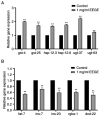Ethyl acetate extract of Gastrodia elata protects Caenorhabditis elegans from oxidative stress and amyloid β peptide toxicity
- PMID: 37522064
- PMCID: PMC10375435
- DOI: 10.3892/etm.2023.12104
Ethyl acetate extract of Gastrodia elata protects Caenorhabditis elegans from oxidative stress and amyloid β peptide toxicity
Abstract
Gastrodia elata Blume is a traditional Chinese medicine with a long history, which has numerous pharmacological activities, such as anti-inflammation, anti-oxidation and protection of nerves. The present study investigated the regulatory effect of ethyl acetate extract of Gastrodia elata (EEGE) on the β-amyloid (Aβ) toxicity of Caenorhabditis elegans (C. elegans). First, the main components of EEGE were analyzed using high-performance liquid chromatography, and the total phenols, total flavonoids and total antioxidant capacity of EEGE were determined. Next, the regulation effect of EEGE on Aβ-induced toxicity of C. elegans was evaluated through experiments on nematode paralysis, lifespan, oxidative and heat stress, locomotor ability, reproductive ability, reactive oxygen species (ROS) level, Aβ aggregation test, malondialdehyde (MDA) level, catalase (CAT) activity and superoxide dismutase (SOD) activity. Finally, the mechanism of EEGE was elucidated using RNA sequencing (RNA-Seq) and the expression levels of related genes were verified using quantitative PCR. The present study revealed that the main components of EEGE included phosphorylated (p)-hydroxybenzyl alcohol, p-hydroxybenzaldehyde and 4,4'-dihydroxydiphenylmethane, possessing strong in vitro free radical scavenging and reducing abilities. In addition, after the intervention of EEGE, the paralysis of nematodes could be delayed, the survival time of the nematodes was prolonged, the survival rate of the nematodes under stress (high temperature and oxidation) conditions was improved, the activity capacity and reproductive capacity of the nematodes were improved, the activities of SOD and CAT were improved and the levels of ROS and MDA were reduced. Notably, EEGE directly inhibited Aβ plaque aggregation in nematodes. RNA-Seq analysis showed that EEGE regulated metabolism and longevity-related genes, and these genes were regulated by the insulin/IGF-1 signaling (IIS) pathway. Therefore, the present study hypothesized that the regulatory mechanism of EEGE was significantly related to the IIS pathway. The present research results demonstrated that the protective effect of EEGE on transgenic C. elegans was to reduce Aβ protein aggregation, improve the in vivo antioxidant level, effectively remove free radicals and to regulate the expression of genes related to IIS pathway, thereby reducing Aβ-induced toxicity and delaying nematode paralysis.
Keywords: Alzheimer's disease; Gastrodia elata Blume; RNA sequencing; oxidative stress; β-amyloid.
Copyright: © Shi et al.
Conflict of interest statement
The authors declare that they have no competing interests.
Figures






Similar articles
-
4,4'-methylenediphenol reduces Aβ-induced toxicity in a Caenorhabditis elegans model of Alzheimer's disease.Front Aging Neurosci. 2024 May 30;16:1393721. doi: 10.3389/fnagi.2024.1393721. eCollection 2024. Front Aging Neurosci. 2024. PMID: 38872629 Free PMC article.
-
P-hydroxybenzaldehyde protects Caenorhabditis elegans from oxidative stress and β-amyloid toxicity.Front Aging Neurosci. 2024 May 22;16:1414956. doi: 10.3389/fnagi.2024.1414956. eCollection 2024. Front Aging Neurosci. 2024. PMID: 38841104 Free PMC article.
-
Deer antler extracts reduce amyloid-beta toxicity in a Caenorhabditis elegans model of Alzheimer's disease.J Ethnopharmacol. 2022 Mar 1;285:114850. doi: 10.1016/j.jep.2021.114850. Epub 2021 Nov 19. J Ethnopharmacol. 2022. PMID: 34801608
-
The rhizome of Gastrodia elata Blume - An ethnopharmacological review.J Ethnopharmacol. 2016 Aug 2;189:361-85. doi: 10.1016/j.jep.2016.06.057. Epub 2016 Jul 1. J Ethnopharmacol. 2016. PMID: 27377337 Review.
-
Research progress of Gastrodia elata Blume polysaccharides: a review of chemical structures and biological activities.Front Chem. 2024 Jul 2;12:1395222. doi: 10.3389/fchem.2024.1395222. eCollection 2024. Front Chem. 2024. PMID: 39015542 Free PMC article. Review.
Cited by
-
4,4'-methylenediphenol reduces Aβ-induced toxicity in a Caenorhabditis elegans model of Alzheimer's disease.Front Aging Neurosci. 2024 May 30;16:1393721. doi: 10.3389/fnagi.2024.1393721. eCollection 2024. Front Aging Neurosci. 2024. PMID: 38872629 Free PMC article.
-
P-hydroxybenzaldehyde protects Caenorhabditis elegans from oxidative stress and β-amyloid toxicity.Front Aging Neurosci. 2024 May 22;16:1414956. doi: 10.3389/fnagi.2024.1414956. eCollection 2024. Front Aging Neurosci. 2024. PMID: 38841104 Free PMC article.
References
-
- Mohsenzadegan M, Mirshafiey A. The immunopathogenic role of reactive oxygen species in Alzheimer disease. Iran J Allergy Asthma Immunol. 2012;11:203–216. - PubMed
-
- Alafuzoff I, Pikkarainen M, Arzberger T, Thal DR, Al-Sarraj S, Bell J, Bodi I, Budka H, Capetillo-Zarate E, Ferrer I, et al. Inter-laboratory comparison of neuropathological assessments of beta-amyloid protein: A study of the BrainNet Europe consortium. Acta Neuropathol. 2008;115:533–546. doi: 10.1007/s00401-008-0358-2. - DOI - PubMed
-
- Zhang X, Kang X, Du L, Zhang L, Huang Y, Wang J, Wang S, Chang Y, Liu Y, Zhao Y. Tanshinone IIA loaded chitosan nanoparticles decrease toxicity of β-amyloid peptide in a Caenorhabditis elegans model of Alzheimer's disease. Free Radical BiolMed. 2022;193:81–94. doi: 10.1016/j.freeradbiomed.2022.09.030. - DOI - PubMed
Grants and funding
LinkOut - more resources
Full Text Sources
Miscellaneous
